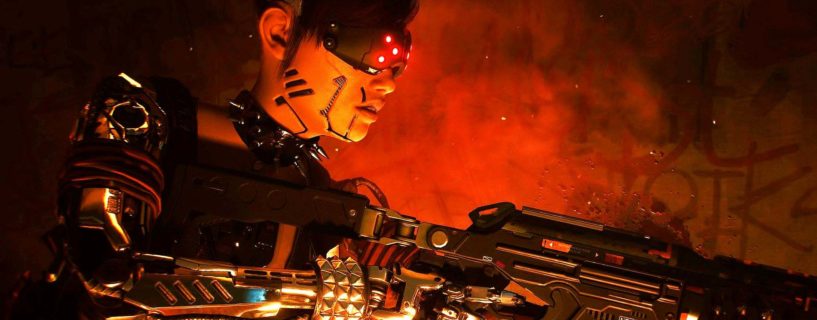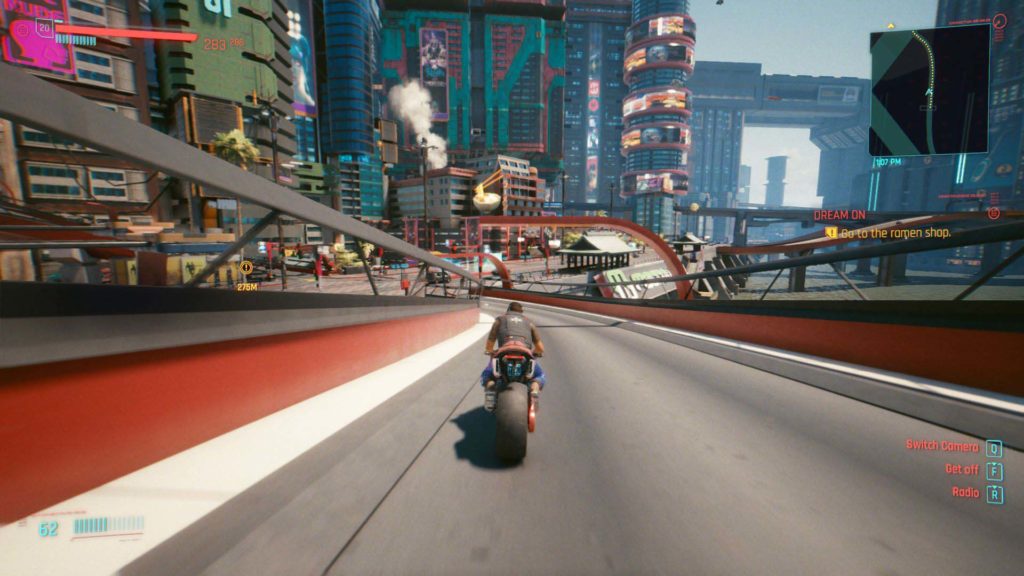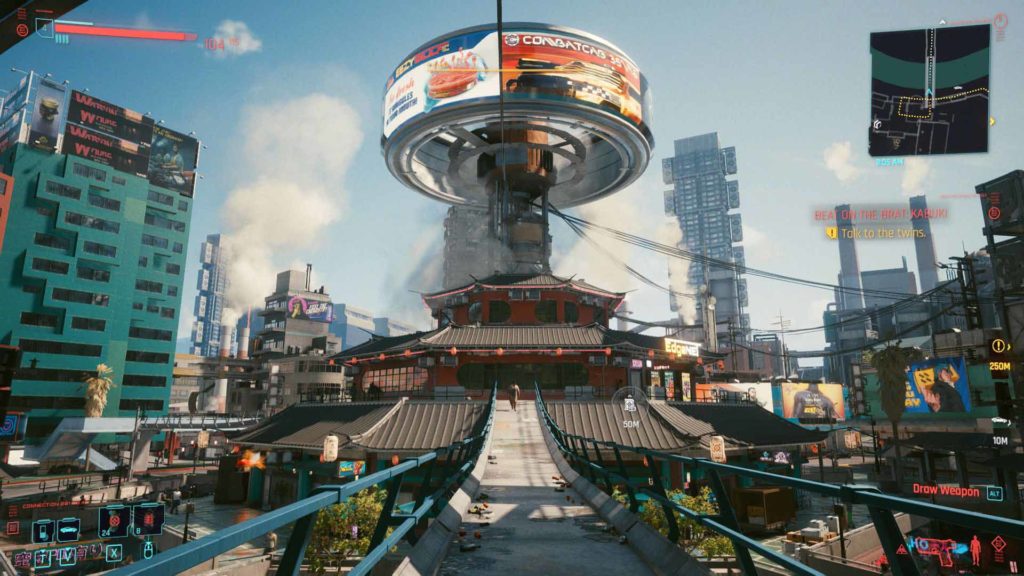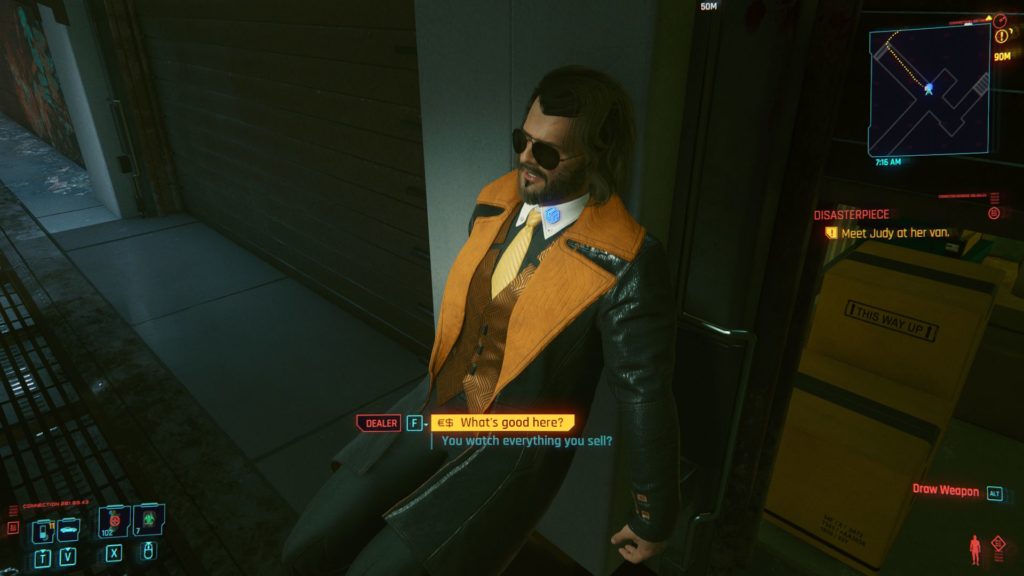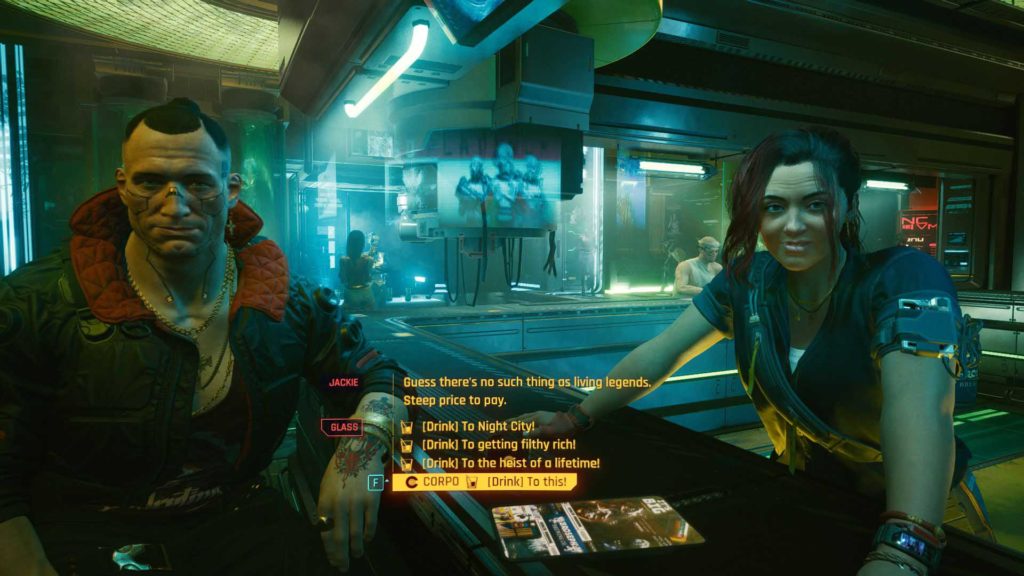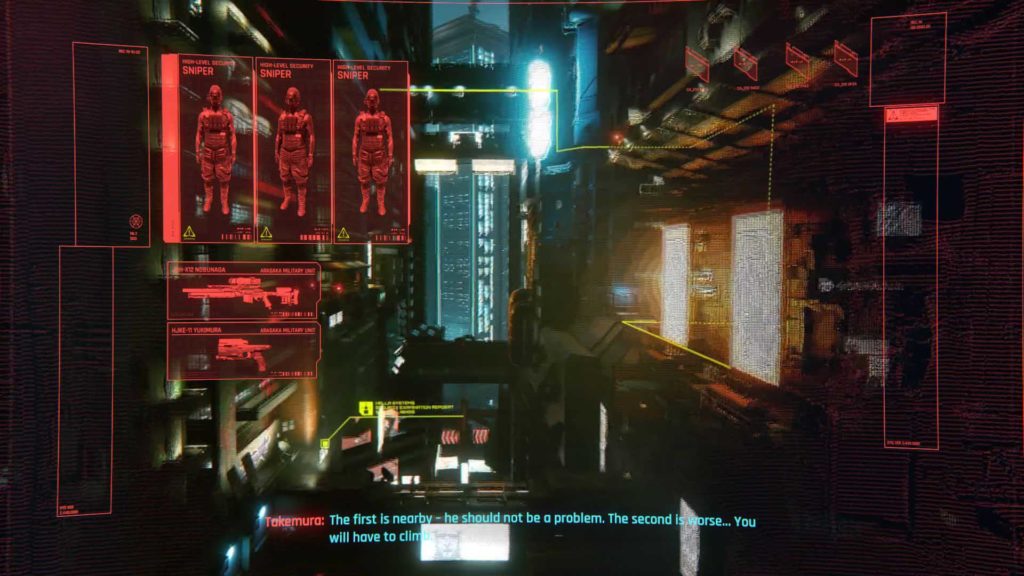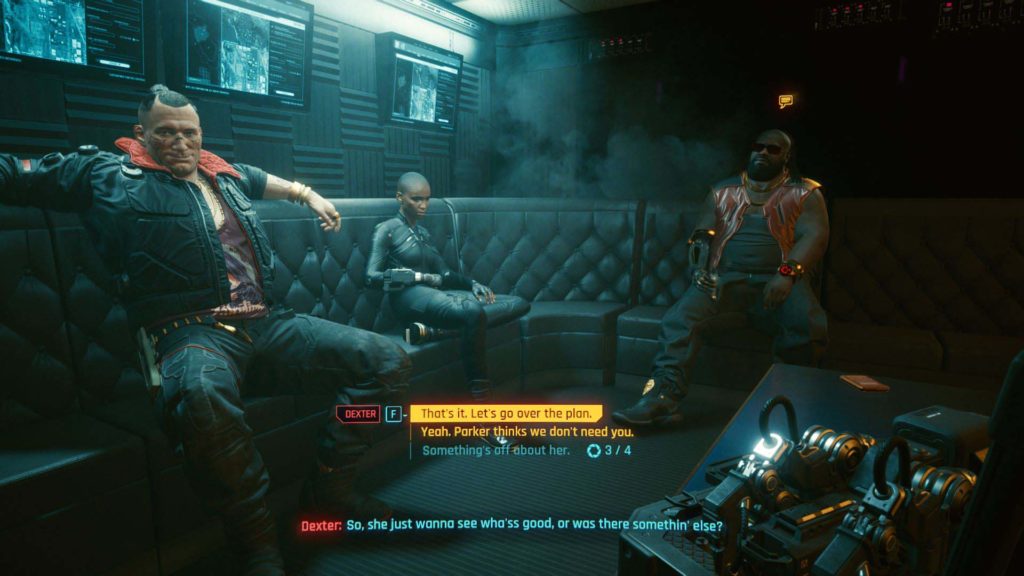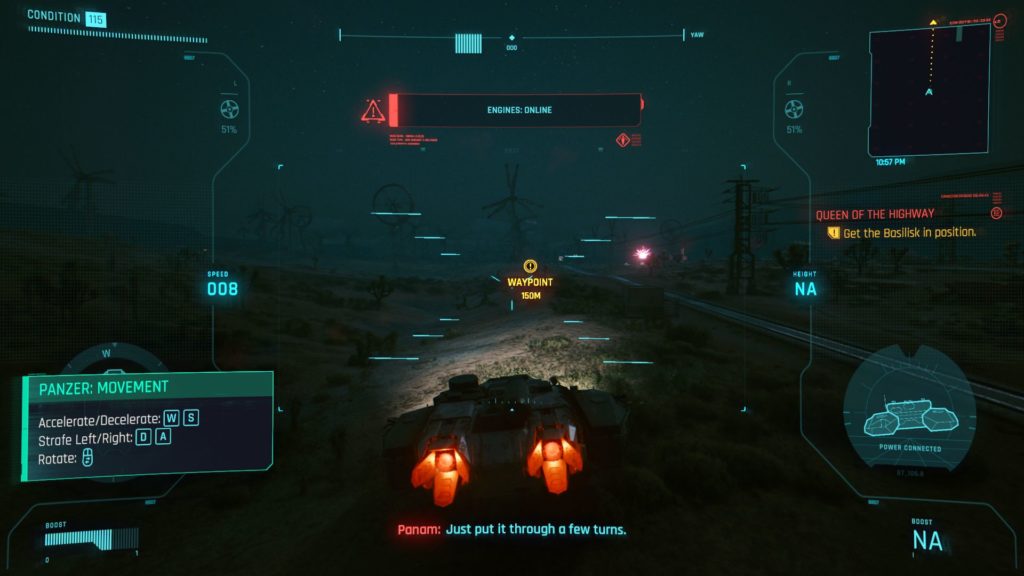I’m leaning over the river, beneath a busy overpass. The water reflects a kaleidoscope of neon from the corporate megabuildings over the way. It’s night-time in Night City, but there isn’t a star in the sky. Powerful floodlights have washed them away to project a scrawl of advertisements.
It’s a perfect image of Cyberpunk 2077’s dystopia: a hyper-capitalist future in which megacorporations long ago exceeded governments’ ability to contain them. Nothing is sacred; everything is commodifiable. Cyberpunk’s greatest success is in its commitment to this setting.
There are some truly amazing stories to experience in Night City. Its people crawl beneath the boots of competing megacorps and wrestle with the infernal technologies they’ve unleashed. I meet politicians whose minds are being rewritten; witness a courteous AI’s disintegration into sinister fragments, each insisting on their right to exist; and storm a chop shop that values human lives less than their cybernetic implants. I meet a serial murderer who finds God, and a producer of braindances – multi-sensory VR movies – who plans to debase the profundity of the murderer’s search for atonement by filming and selling it. Tragically, the murderer is complicit in his exploitation, hoping that the broadcast of his final gesture will inspire people to realise the meaninglessness of the system that distributed it to them for a profit.
No other open-world game can tell stories like this, because they stem directly from Cyberpunk’s setting. The main storyline is the best of them all, and appropriately enough, explores what it proposes as capitalism’s ultimate profanity: the appropriation of the soul itself. Ironically, the megacorp attempting this inadvertently resurrects its greatest opponent: the legendary ‘rockerboy’ Johnny Silverhand, played by Keanu Reeves, whose digitised psyche finds new life in your own brain.
Silverhand is a brilliant character, brilliantly deployed. He’s arrogant, acerbic, and unapologetic about his determination to tear the system down at any cost – for him, the ends justify all conceivable means. In a sane world he’d have plenty of faults, but in a world where everything is for sale, his refusal to sell out redeems all manner of sins. If you, like us, have been wondering where the ‘punk’ is in Cyberpunk – a game which, elsewhere, lets you help the police crack down on mohawked street gangs – then it’s in Silverhand.
PERFORMANCE
You may notice some inconsistencies in the screenshots in this review. The reason is ray tracing. Without it, Night City looks flat and washed out, but I’d been struggling to maintain a decent frame rate with it until the arrival of Nvidia’s Cyberpunk 2077 drivers and the day-zero patch.
You’ll have both of those things though, so if you have a ray tracing card, you can probably look forward to a beautiful experience. I was using a 2070 Super, and after the updates was able to get 30 to 50fps on medium ray tracing settings. If that’s not enough for you, DLSS was pretty good at finding a few more frames. So in the end was pleased with how Cyberpunk looked and ran on my rig, and expectations were high.
I got comfortably above 60fps at all times on the non-ray tracing ultra preset, but ray tracing makes an even bigger difference to the detail and shading of the game than you’d expect, so do be wary if you don’t have a card capable of it.
This is no cameo, either. Besides his big speeches during the story, Silverhand regularly pops up to offer witticisms during minor quests – he’ll even comment on trivia in the open world. He’s sharply written, never without an answer or a withering comeback, and Reeves’ delivery is irresistible, veering between languid put-downs that drip with ‘I don’t give a fuck’ energy and righteously, infectiously impassioned tirades against the deeply screwed-up world that he’s now powerless to change except through you.
As terrifying as that world is, you’ll still enjoy your visit. CDPR has spoken of the four artistic movements around which Night City was designed, and they help it feel like the 57 years between now and then have been full of organic growth and shifting fashions. There’s the obligatory ’80s retrofuturism of neon and polyester, like Doc Brown’s DeLorean crashed into a kids’ laser quest centre. By contrast, the world of the rich and of megacorps is cold, shiny, and minimalist – all empty space and devastatingly placed luxury. Blade Runner’s belching smokestacks are found in the industrial district of Arroyo.
I’ll often eschew fast travel just to drive around Night City, listening to the excellent original music on the radio, even for journeys of multiple kilometers. But the main story shows it at its very best. Elaborate heists not unlike GTA V‘s feature prominently, but GTA never had a setting like this to work with. These are some of the coolest set pieces in gaming. One highlight is a corporate parade, in which I shove my way through chattering crowds while pagodas and holographic dragons float through the air between high-rise apartment complexes.
These heists are planned in hushed voices and grimy bars, and seeing out of protagonist V’s eyes pulls you into the conversation. I can’t quantify how much poorer the game would’ve been in third-person, but: lots. It’s equally perfect when I emerge onto the street – Night City’s megalithic megabuildings could never loom above you quite as they do from any other perspective.
But most open worlds fray at least a little under closer scrutiny, and Night City is no exception. Ordinarily I’d think it petty to criticise a game for repeating established ‘gamey’ quirks, but Cyberpunk feels like it aspires to break precedents, so: it’s a bit jarring that I can still go from consoling someone about the loss of their friend to picking their apartment clean of every valuable without comment or consequence. And why, why, are there so many dildos? They’re everywhere, studded purple cocks just lying on the street, as if in 2077 the climate crisis has worsened to the point of flaccid rain.
And that’s just the stuff that’s intentional. Even after a 49GB day-zero patch – the product of CD Projekt Red’s unfortunate last-minute crunch – Cyberpunk is still plagued with bugs. These include quest progression issues and save-file corruption – though fortunately it autosaves so often that I never lose too much progress – and an amazing variety of visual glitches of which floating objects are only the most noticeable. On one memorable occasion, I give a peddler of illegal snuff braindances two buckshot shells to the face, point-blank. Rather than his head exploding, he sinks gently into a squat against the wall, his mouth open in surprise. Though he’s dead, I can still talk to him and browse his wares – when I ask about business, the corpse’s head rotates to face me, jaw slack, then snaps back to staring straight ahead. It’s extraordinarily creepy.
Apt as it may be, CDPR’s version of first-person is stiff and juddering when the action picks up. It’s like standing on the back of an off-roading pickup truck. This has the frustrating effect you’d expect when it comes to shooting straight, and when I do land my shots, even street-level goons are annoyingly spongey (note: I’ve been playing on hard difficulty). Moving between cover and slipping into it is also never as smooth as it should be.
Matters improve, a bit. The stiffness never goes away but it does get less noticeable as I acclimatise, while the sponginess abates as I embrace a playstyle. There are five broad attributes in Cyberpunk, each of which governs two to three perk trees. These perks start as pragmatic necessities – they fix that sponginess by improving the damage of core weapons, at which point combat finds a bit of a rhythm.
This is somewhere between an open-world game and an immersive sim, so encounter spaces are not designed for pure adrenaline-pumping euphoria as they are in say, Doom Eternal. Rather, combat is methodical: I get into cover and squeeze out a few rounds, until effective enemy AI responds to my position with grenades and flanking tactics, and I’m obliged to relocate.
More flexibility and excitement comes with higher-level perks, which are all about becoming your own particular badass. You can enhance exotic weapons like katanas, clubs, and your bare fists. A perk that increases rifle damage the further I am from enemies is the finishing touch to my sniper build, while a perk in the Stealth tree lets me throw knives for slick and silent takedowns.
But combat is only one way to penetrate an enemy base. Cyberpunk’s attributes govern the other methods, too, improving your sneaking skills or literally opening new doors. Through hacking, you can turn security turrets on their owners or download money from computer terminals, and it’s as fun as it was when Deus Ex did it almost two decades ago – but not much different. One of Cyberpunk’s only forward steps is bringing it into combat: time slows as you scan enemies and navigate a slick interface of ‘quickhacks’ that can reset their hostility, jam their guns, detonate their grenades, or even – if you invest the perk points – reduce the damage resistance of every linked enemy by 30%, which is thrillingly powerful in fights.
THIS IS ONE OF THE MOST EXPLICITLY POLITICAL GAMES EVER MADE – ANYONE WHO INSISTS IT’S MEANINGLESS ESCAPISM IS DELUDED
In other areas, Cyberpunk 2077 actually takes a step back. In Deus Ex: Human Revolution, I remember demolishing the smug William Taggart in a dialogue challenge by dropping evidence that I’d discovered while exploring. In Cyberpunk you can dig up similar dirt, and interrogate people in a similar way, but details from the former seldom inform the latter. The only unique dialogue options are unlocked by my attributes and backstory, and I interrogate suspects through intuition: a cyberware surgeon (or ‘ripperdoc’) seems like a wimp, so I elect to hit him and he folds like a napkin. I had the evidence to catch him in his lies, but no way of putting it to him.
Loot is the final component of your build, and it works similarly as it does in The Witcher 3: you’re showered with it, most of it will be useless duplicates which you’ll scrap or sell, and until you do it’ll annoy you by burdening your limited carry weight. Some weapons are ‘iconic’ and can be continually upgraded, so in theory you can take them with you throughout the story, but the cost to do so rises so steeply that I’m soon out of materials and my favourite guns are again outpaced by the shower of dupes. In Assassin’s Creed Valhalla, all loot works like Cyberpunk’s iconic weapons, and upgrading is perfectly paced. Were Cyberpunk to fully imitate it, it would save so much busywork, and deliver on CDPR’s stated goal to let you choose how to play as your own cyberpunk badass. Most of the game’s systems are good at this, but loot gets in the way, especially clothing: your clothes comprise your armour value, obliging you to swap that badass armoured jacket for a bland cotton shirt if you want to protect yourself, against all sense of both intuition and fashion.
If I seem to be picking nits, it’s because expectations, and thus standards, are high. This is one of the most anticipated games in years, and CDPR’s positioning of it as a once-in-a-generation event invites comparison with Rockstar’s modus operandi. Ultimately, it doesn’t smash quite as many precedents as GTA V or Red Dead 2, or even Deus Ex, but it does a few.
It may be remembered as a game for our times. I’m not about to claim that commodifying the soul is an imminent prospect, but painting over the night sky to sell shit? That was in the news of 2019. That’s why those floodlights stuck in my memory. I’m not, a priori, an anti-capitalist. Implementation is everything, and kept on a tight leash, private enterprise drove an unprecedented rise in living standards during the 20th century. But when our own modern-day megacorps can avoid paying a fair share of tax, and their owners can double their net worth during a pandemic which has eradicated small businesses, sent unemployment skyrocketing, and caused the deaths of thousands of people, it’s clear the leash has got slack. In this context, Cyberpunk’s anti-corporate rage is cathartic to say the least.
Retroactive trigger warning about ‘politics in games’ for whoever dislikes such things, by the way, but if that’s you, then you’d best steer clear of Cyberpunk 2077 if you stand by your claimed convictions. This is one of the most explicitly politically charged games ever made – Mike Pondsmith designed the tabletop game upon which it’s based as a “cautionary tale,” and after the killing of George Floyd back in June, reiterated that his universe is “a warning, not an aspiration“. Anyone who insists it’s pure, meaningless escapism is hopelessly deluded.
Even if such sentiments are uttered in sincere good faith, I think it’s a tragic diminishment of our medium to insist that it shouldn’t tackle politics. Cyberpunk 2077 might not push quite as many boundaries in game design as a landmark release could, but if it can convince more people that games can and should take a position on issues of substance rather than peddle mindless thrills, that’ll be a worthy legacy.

